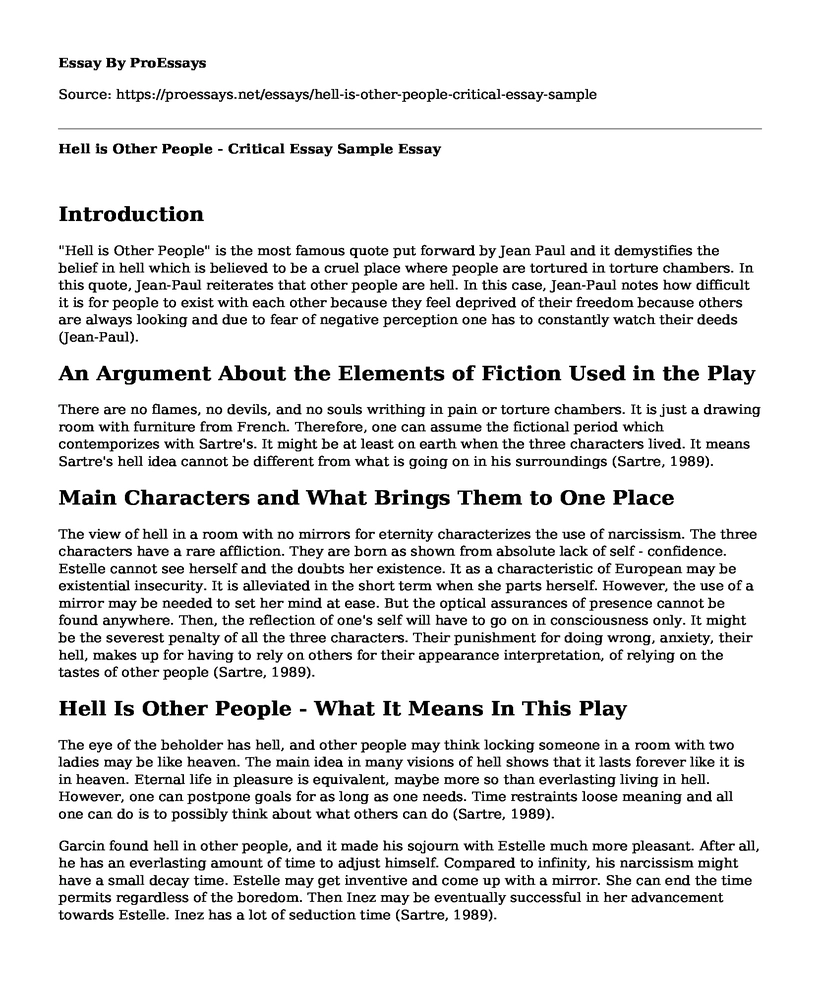Introduction
"Hell is Other People" is the most famous quote put forward by Jean Paul and it demystifies the belief in hell which is believed to be a cruel place where people are tortured in torture chambers. In this quote, Jean-Paul reiterates that other people are hell. In this case, Jean-Paul notes how difficult it is for people to exist with each other because they feel deprived of their freedom because others are always looking and due to fear of negative perception one has to constantly watch their deeds (Jean-Paul).
An Argument About the Elements of Fiction Used in the Play
There are no flames, no devils, and no souls writhing in pain or torture chambers. It is just a drawing room with furniture from French. Therefore, one can assume the fictional period which contemporizes with Sartre's. It might be at least on earth when the three characters lived. It means Sartre's hell idea cannot be different from what is going on in his surroundings (Sartre, 1989).
Main Characters and What Brings Them to One Place
The view of hell in a room with no mirrors for eternity characterizes the use of narcissism. The three characters have a rare affliction. They are born as shown from absolute lack of self - confidence. Estelle cannot see herself and the doubts her existence. It as a characteristic of European may be existential insecurity. It is alleviated in the short term when she parts herself. However, the use of a mirror may be needed to set her mind at ease. But the optical assurances of presence cannot be found anywhere. Then, the reflection of one's self will have to go on in consciousness only. It might be the severest penalty of all the three characters. Their punishment for doing wrong, anxiety, their hell, makes up for having to rely on others for their appearance interpretation, of relying on the tastes of other people (Sartre, 1989).
Hell Is Other People - What It Means In This Play
The eye of the beholder has hell, and other people may think locking someone in a room with two ladies may be like heaven. The main idea in many visions of hell shows that it lasts forever like it is in heaven. Eternal life in pleasure is equivalent, maybe more so than everlasting living in hell. However, one can postpone goals for as long as one needs. Time restraints loose meaning and all one can do is to possibly think about what others can do (Sartre, 1989).
Garcin found hell in other people, and it made his sojourn with Estelle much more pleasant. After all, he has an everlasting amount of time to adjust himself. Compared to infinity, his narcissism might have a small decay time. Estelle may get inventive and come up with a mirror. She can end the time permits regardless of the boredom. Then Inez may be eventually successful in her advancement towards Estelle. Inez has a lot of seduction time (Sartre, 1989).
Different Colors That Used In Each Furniture and What They Symbolize
The people in the room, Inez, Estelle, Garcia, the couches of livid green, wine-red, and blue do not match with one another. They are also present in the Second Empire Style and boringly done to annoy anyone who adores clean lines. Inez complains of the Second Empire style of furniture, saying that the room setting was put together purposefully for them (Sartre, 1989).
Irony When Garcin Had the Chance to Leave the Place, But He Did Not - Why He Did That
Garcin, attentive of how much agony he can cause Inez, at long last agreed to pleas made by Estelle. He admitted that he wanted her and made love with her in front of Inez. However, he seems more severe and more worried. He realized Estelle did not trust him (Sartre, 1989).
The Knife Symbol
In No Exit, Jean-Paul Sartre, the knife apart from being used by Estelle to try to kill Inez after which she fails it is used as a symbol to differentiate being and nothingness which is used by Jean Paul to explain the difference between essence and existence. In this case, the knife is used to show that existence precedes essence when perceived from human perception and also essence precedes existence on everything else. In this case, there is a pre-decided essence for the knife to open letters and cut pages of a book and the knife becomes useless in the absence of the books. On the other hand, human beings cannot be put in the same perspective as the knife because man does not have a particular predetermined essence. In this case, human beings, unlike the knife, cannot be depicted as useless because initially, man did not have any specific or defined use. Secondly, the knife is used as a symbol of futility in the play when Estelle fails to stab Inez with it which indicates that it is impossible to change ourselves from our role in each other lives. This symbolism affirms the theme in No Exit by Jean-Paul that hell is indeed other people (Jean-Paul).
Work Cited
Sartre, Jean-Paul. "No exit and other plays." New York: Vintage (1989).
Cite this page
Hell is Other People - Critical Essay Sample. (2022, Mar 30). Retrieved from https://proessays.net/essays/hell-is-other-people-critical-essay-sample
If you are the original author of this essay and no longer wish to have it published on the ProEssays website, please click below to request its removal:
- Essay Example on Evaluation of Mary Shelley's Frankenstein
- Comparison of the Novels Metamorphosis and Trials Essay
- Creativity and Rationality in Charlotte Gilman's The Yellow Wallpaper - Literary Analysis Essay
- Michael Radford's "1984" and George Orwell's "Nineteen Eighty-Four" Essay
- Essay Example on My Son Blazes Within Me: Exploring Family, Spirituality & More
- Book Review Sample on 'The Miser': Greed, Love & Dubious Coincidences
- Essay Example on Genni Genn's Versions: A Canadian Novella & Other Stories







